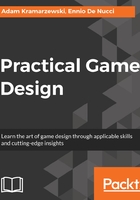
Priorities and dependencies
Knowing the priority order in which things should be made is hugely important. Even the smallest changes to the story or base game mechanics can have rippling effects across the whole game, potentially leading to a lot of wasted development effort.
One way of quickly communicating and visualizing dependencies between tasks and parts of the game is to create a dependency stack, a diagram that lays down the various game features and pieces of content and the relationships between them (you can use the same tools as when creating a menu flow). Note that this is not a tool that helps communicate the structure or flow of the game; it's used purely to prioritize tasks.
If diagrams are too much, a simple spreadsheet can help you order and prioritize work. All you need to do is to take a list of features and content (simply expand your content lifespan sheet, or an art asset sheet), then add fields for priority and dependency.
Dependencies are not that hard to figure out. In an action game, your enemies won't work if players have no tools to defeat them, which in turn won't work if they can't control their characters, and so on.
As far as using numbers for priority, I recommend putting 0 as the least important and going up from there, this way it's easier to make something more important—simply put critical things as 1000, then start going down. Anything below a certain threshold can be treated as optional.
When designing any game feature (or game for that matter), create a list of components that would comprise your minimum viable product (MVP), that is, key elements without which you wouldn't be able to release said feature/product. If there's a strong indication of not meeting the MVP when planning the work, you might get ready to save time by cutting it all out. Defining the MVP can sound a little restrictive at first, but it helps your team focus first and foremost on what's essential for the feature/game you're working on.
Follow the MVP by clearly describing what your desiredoutcome is. And finally, don't hesitate to add a wishlist, your best-case scenario. Perhaps there's an extra behavior or a set of parameters you could use? To put this into an example, don't ask for five power-ups, ask for no less than three power-ups (to make the feature viable), ideally we'd go for five. [Optional]: We could introduce three ratings for each power-up, this way we can take five power-ups and turn them into 15!